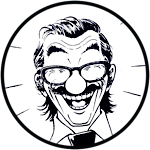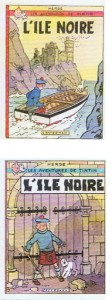
“The Black Island” is the 7th volume of The Adventures of Tintin and was published in its original version in Le Petit Vingtième weekly from April to November 1937. In 1943, “The Black Island” was coloured and re-drawn in Hergé‘s distinctive ligne-claire style for republication. In the early 1960s however, Hergé’s English language publishers, Methuen, planned on translating and publishing “The Black Island” for the British market.
But they drew up a list of no less than 131 errors that they asked Hergé to rectify before they would publish it in English. This would mean quite a lot of extra work.
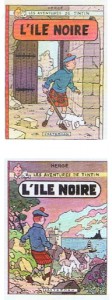
At the time, Hergé was busy producing the twenty-second Tintin story, “Flight 714”, and with no extra time on his hands he sent his assistant Bob De Moor to Britain in October 1961 to undertake research into contemporary British society and culture. For De Moor it was a dream trip, which he would later talk about – completed with funny events (true and false) that happened along the voyage – to friends. He was a true story-teller after all.
While in England, De Moor sought out various contemporary uniforms to use as a basis for more accurate illustrations. A police constabulary for instance lent him a police uniform, but when he asked British Rail if he could borrow one of their uniforms, their staff were suspicious and refused.
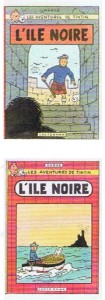
Bob De Moor, Roger Leloup and Jacques Martin would work on the new version from 1961 till 1965. Leloup for instance would redraw the multiple aircrafts and Jacques Martin the cars featured throughout the story. Noticeable in the updated version was that the old steam railways had been replaced by electrified alternatives. Adverts for the genuine Johnnie Walker whisky were replaced by adverts for the fictional alternative, Loch Lomond whisky, while a Sussex County Council signpost was added to page 11. Various English towns and villages were renamed, with Puddlecombe becoming Littlegate, and Eastbury becoming Eastdown, while Scottish pub Ye Dolphin was renamed The Kiltoch Arms. The police were no longer depicted as carrying guns. Note that the journalists Christopher Willoughby-Drupe and Marco Rizotto, who had first appeared in “The Castafiore Emerald” (1963), were retroactively added into the background of one scene.
At the same time Jacques Martin and Bob de Moor had also started on a new Jo et Zette album, “La Main Noire“. But they had to abandon the project because the work on “The Black Island” took too much work.
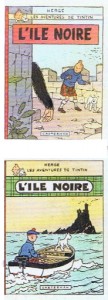
While being on holiday on Sardinia, Italy in June 1965, Hergé received 8 projects for the cover of the new edition. These were created by Bob De Moor and can all be seen on the left.
The new version would be serialized in Tintin magazine from May 1965, before Casterman published it in a collected volume in 1966.
A large format album depicting all 3 versions, “Dossier Tintin – L’île noire”, was published in 2009 and if you didn’t pick it up then, you can still buy it via Amazon France.
A recommended, yet pricy purchase!
